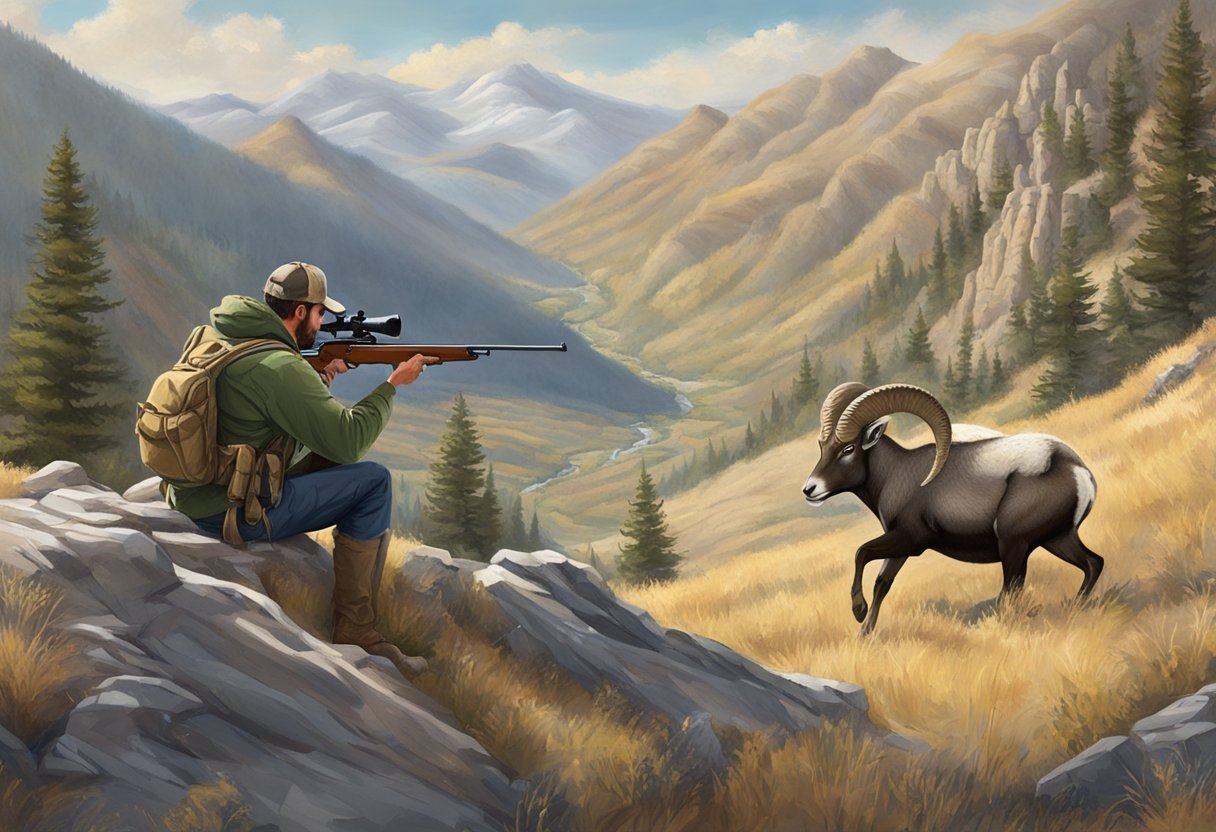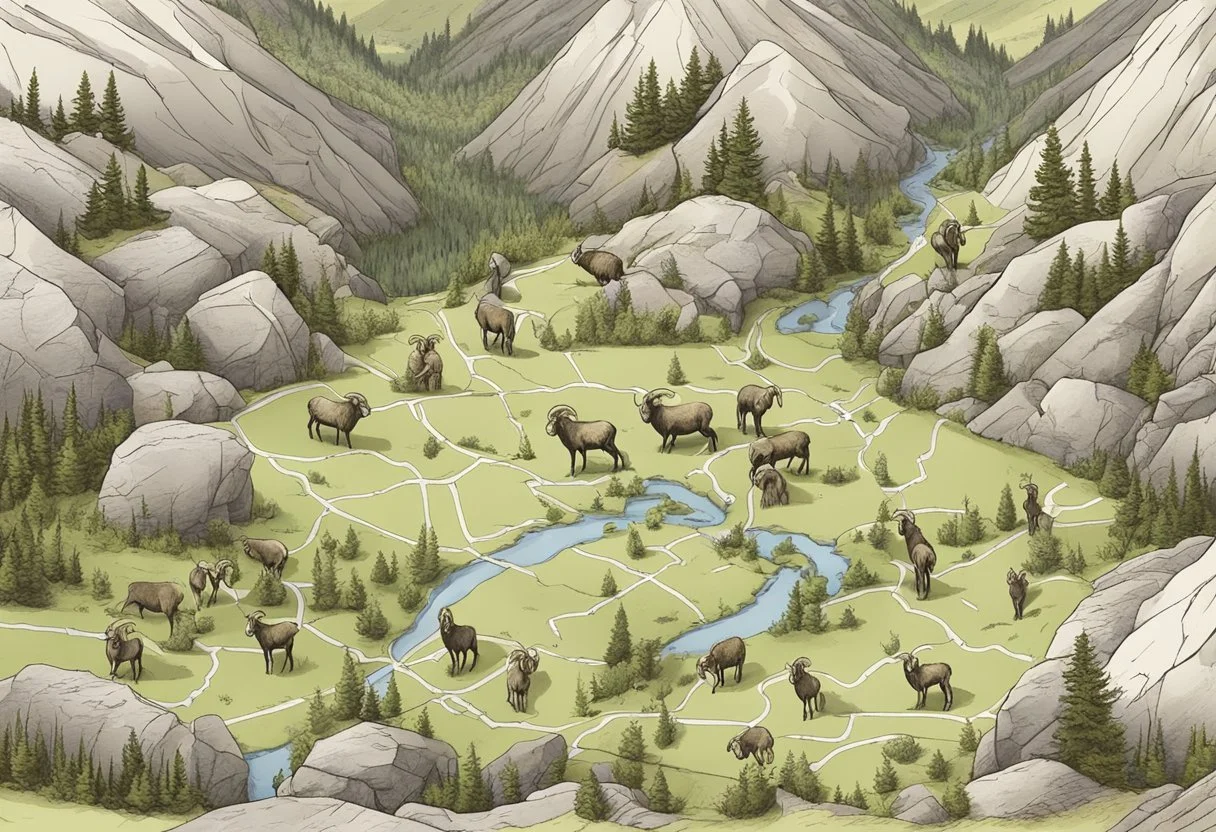Bighorn Sheep Hunting for Beginners
Essential Tips and Strategies
Discover > Hunting for Dummies > Bighorn Sheep Hunting for Beginners
Bighorn sheep, known for their impressive size and striking horns, are a sought-after game for hunting enthusiasts. These majestic animals inhabit rugged and challenging terrain, making hunting a true test of skill and determination. As a beginner, understanding the nature of bighorn sheep and their habitat and proper preparation and hunting techniques are crucial for a successful and rewarding experience.
To prepare to hunt bighorn sheep, beginners must first familiarize themselves with the rules and regulations in their chosen hunting area. Obtaining the appropriate license and understanding the hunting season timeline for bighorns. Additionally, being conscious of conservation efforts and hunting ethics will ensure a sustainable hunting practice and a positive impact on the species' population.
Another vital aspect of bighorn sheep hunts for beginners is acquiring the proper gear and developing the necessary skills. From accurate long-range shooting to safely navigating steep and treacherous landscapes, honing these abilities will significantly increase any novice hunter's chances of success.
Understanding Bighorn Sheep
Species and Subspecies
Bighorn Sheep (Ovis canadensis) are divided into two main subspecies: Rocky Mountain Bighorn Sheep (Ovis canadensis canadensis) and Desert Bighorn Sheep (Ovis canadensis nelsoni). Rocky Mountain Bighorn Sheep are the larger of the two, with rams weighing up to 300 lbs (136 kg), while the Desert Bighorn is slightly smaller with rams weighing up to 200 lbs (90 kg).
Habitat and Distribution
North American wild sheep, such as Bighorn Sheep extend across the Western states from Montana and British Columbia in the north to Mexico in the south. Rocky Mountain Bighorn Sheep inhabit alpine meadows, grassy slopes, and Montana, Idaho, Wyoming, Alberta, British Columbia and other Canadian provinces. Desert Bighorn Sheep, on the other hand, are adapted to arid environments such as the deserts and mountain ranges of California and Mexico.
Behavior and Diet
Bighorns are wild sheep and herbivores with a diet primarily consisting of grasses, sedges, and forbs. However, they will also consume shrubs and trees if other food sources are scarce. Their unique digestive system allows them to extract nutrients from low-quality food sources. Bighorns are also social animals, typically forming groups known as bands. During the breeding season, dominant rams compete for ewes by engaging in butting contests.
Conservation Status
Though Bighorn Sheep populations have been affected by habitat loss, disease, and unregulated Bighorn Sheep hunts, conservation efforts have helped stabilize their numbers. Currently, the International Union for Conservation of Nature (IUCN) lists the global conservation status of Bighorn Sheep as "Least Concern." However, individual subspecies may have varying levels of protection based on regional population sizes and specific threats. Hunters should always adhere to local regulations to ensure the long-term survival of these iconic animals.
Preparation for Hunting
Physical and Mental Preparation
Preparing for successful Bighorn Sheep hunts requires both physical and mental endurance. These elusive animals live in rugged terrain that often demands extensive hiking and challenging climbs. Sheep hunters consider the following preparation for Bighorn hunting:
Develop a strong cardio routine to build endurance for long hikes.
Improve your overall strength, focusing on legs and core muscles.
Practice hiking with heavy loads to simulate carrying your hunting gear.
Build mental toughness by practicing mindfulness, visualization, and relaxation techniques.
Research and Scouting
When you start with Bighorn Sheep hunts, it is vital to understand the habitat and behavior of these animals. Before you hunt sheep, invest time in scouting and research to maximize your chances of success:
Utilize maps and satellite images to locate terrain features bighorn sheep favor, such as cliffs, steep slopes, and escape routes.
Study weather patterns as they can affect sheep behavior and movement.
Visit your intended hunting location in advance to familiarize yourself with the area.
To identify potential sheep locations, use binoculars or a spotting scope for distant glassing.
Watch videos and read articles from experienced hunters to learn more about bighorn sheep habits and hunting strategies.
Selecting the Right Gear
Packing the right gear for a bighorn sheep hunt can be the difference between success and disappointment. Carefully consider which items to bring with you:
Legal Considerations
Understanding Regulations
When planning a bighorn sheep hunt, hunters must familiarize themselves with the activity's various regulations. Each region has distinct season dates, rules, and requirements. Hunters, especially non-residents, should consult their targeted destinations' authoritative wildlife agency websites for detailed information.
Some general points to consider when you hunt sheep:
Adhering to established bag limits set by regional authorities
Complying with species-specific weapon regulations
Understanding restricted area boundaries during each hunting season
Tags and Permits System
For most bighorn sheep hunts, hunters require specific tags and permits. The process for obtaining bighorn sheep tags varies by region; however, many places utilize a lottery or draw system. Some locations offer opportunities for acquiring tags through:
Raffles: Tickets purchased via the application process to enter a draw for a tag
Bonus point systems: Accumulated points increase the odds of securing a tag in future draws
Preference points: Points increase priority status for obtaining a tag
Planning Your Hunt
Choosing a Location
When planning a bighorn sheep hunt, the first step is to decide on a location. Several environments are known for excellent sheep hunting, including high country, mountain, and desert terrains. You may spend countless hours scouting, but it's essential to do thorough research on the best spots for sheep hunts in each area, especially if you plan on aiming for your Grand slam.
Some popular locations for bighorn sheep hunts include:
High country: Rocky Mountain region
Mountain terrain: Alaska and Canada
Desert terrain: Nevada and New Mexico
A sheep hunter needs to consider his fitness abilities and preferred hunter techniques. Many hunters choose between spot and stalk or hiking when selecting a location.
Deciding on a Hunting Guide or Outfitter
Bighorn sheep hunts can be extremely challenging, and hiring a guide or outfitter can significantly increase your chances of success especially on mountain terrain. Choosing an experienced guide familiar with the specific terrain and local sheep population can help ensure a successful hunt. A guide can also advise on a Bighorn Sheep tag and license in your chosen hunt area.
When comparing guides and outfitters, consider the following:
Experience: How many years of experience do they have guiding sheep hunts?
Success rate: What is their average success rate for clients on sheep hunts?
Equipment: Do they provide suitable gear, or is it a DIY sheep hunting experience?
It may also be helpful to ask for referrals from previous clients to verify the quality of your chosen guide or outfitter.
Time of Year to Hunt
Bighorn sheep hunting typically occurs during the fall season, with October and November being the most popular months. These months provide optimum hunting conditions, as sheep are more active due to the rutting season, and the weather is relatively mild in most locations. Always prepare a sheep hunt schedule, so you are fully aware of the timing of upcoming hunts.
To increase the odds and your chances of success, plan your hunt around the following factors:
Rutting activity: Look for areas with high concentrations of bighorn sheep, as they will be more active during the rut.
Weather: Cooler temperatures in the late fall can make it easier to hike and spot sheep in mountainous and high country terrain.
Local knowledge: Consult with your chosen guide or outfitter about the best time to hunt bighorn sheep in your chosen location and sheep tag requirements. Their knowledge will help you plan more successful and enjoyable Bighorn hunting.
Hunting Techniques
Spot and Stalk Method
The spot and stalk method is a popular hunting technique for beginners targeting bighorn sheep. It involves using high-quality binoculars or spotting scopes to find and observe the animals from a distance before attempting a close approach. Locating mature rams often means hours of glassing across a variety of terrain and topography.
Once a group of bighorn rams or a mature ram has been located, the hunter must carefully plan their approach. Stalking requires skillful hiking, climbing and maneuvering through difficult terrain, while remaining undetected by the sheep. The bedding area of the sheep is often a good location for an ideal stalk. Patience, stealth, and knowledge of the ram's natural predators are essential for a successful stalk.
Effective Ranging and Positioning
Effective ranging and positioning play a vital role in sheep hunting success. Bighorn sheep inhabit steep, rugged terrain, so having significant experience in backcountry hiking and climbing is essential. This enables the hunter to navigate challenging topography and reach a desired position.
Here are some key hunting tips for effective positioning:
Use a quality range finder to determine the distance to the target accurately
Determine the best approach route based on the landscape, wind direction, and visibility
Move cautiously when closing the distance to the target to avoid alerting the bighorn sheep
Field Judging Bighorn Sheep
Field judging is an integral part of sheep hunting and helps hunters determine early if the ram is a suitable target. Factors to consider when field judging a mature ram include:
Horn length: the length of the horn is measured from the base to the tip along the outer curvature
Horn circumference: measure the circumference of the horn at the base, just above the eye ridge
Age: a ram is considered mature when it reaches the age of 8 or 9 years
When estimating the overall "score" of a bighorn sheep, it is necessary to consider all these aspects to determine if the ram meets the criteria for harvest.
Post-Hunt Considerations
Meat Care and Trophy Preparation
After a successful bighorn sheep hunt, proper meat care is essential to ensure the quality of your game animal. It is crucial to field dress the animal as soon as possible after harvest. This involves removing the animal's internal organs such as the heart and lungs, which helps to cool down the meat and prevent spoilage.
It is also important to consider trophy preparation. Depending on your preference, you may want to preserve the full cape (head and neck skin) and horns of the bighorn ram as a mount, or simply clean and preserve the rest of the skull with intact horns. Always handle the trophy with care, as this not only helps preserve the aesthetics but also demonstrates respect for the animal.
Ethical Hunting Practices
Ethical hunting plays a vital role in the conservation efforts of wild sheep populations, particularly as their genetics are prone to negative impacts from overhunting and loss of habitat. By following ethical hunting practices, hunters can contribute to the conservation of this majestic species. Some tips to remember:
Know your target: Study and be able to identify legal game animals, specifically bighorn rams of sufficient horn development.
Practice restraint: Only take shots when certain of a clean and efficient kill.
Respect your quarry: Approach the hunt with reverence and minimize animal suffering.
Sharing Your Experience
Finally, hunters can document and share their bighorn sheep hunting experience with friends, family, and fellow enthusiasts. Consider creating a video or written trip report. This not only serves as a personal keepsake, but it can also help educate and encourage others to practice ethical hunting. Sharing your experience can inspire others to participate in conservation efforts while pursuing their passion for hunting.





